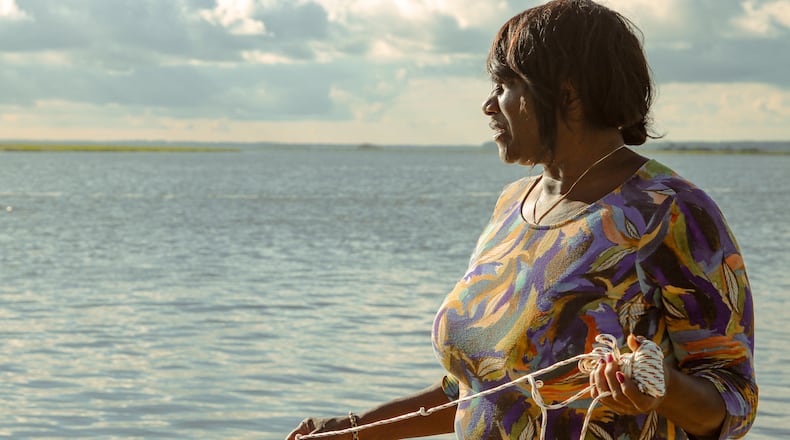DAUFUSKIE ISLAND, S.C. ― For little Sallie Ann Robinson and her nine siblings, crabbing was competition.
Who can catch the biggest? Who has the most? Which technique — fishing line and scoop net, drop basket or cast net — is the most reliable?
“Work and play was part of our way of life,” says Robinson, now a renowned Gullah chef and cookbook author. “If we didn’t go crabbing every day, dinner wasn’t all that tasty.”
The family supper staple, crab rice, just wasn’t the same without the locally caught crustaceans. And the Robinsons purchased the rice for their meals using funds from making and selling deviled crabs to visitors to Daufuskie Island, a small barrier island located a short boat ride from both Savannah and Hilton Head Island, South Carolina.
Blue crabs were — and are — a plentiful yet valuable resource in the Lowcountry. Eight-foot tides flush the marshy environs along the Georgia coast twice a day, creating a nutrient-rich ecosystem where crabs thrive. The meat, once the crab is caught, cooked and picked, is soft and sweet and turns simply made dishes such as Ol’ ‘Fuskie Fried Crab Rice into what Robinson calls, in her Gullah-accented English, “da bomb.”
Credit: handout
Credit: handout
“We were poor but didn’t know it,” said Robinson of her childhood. “We were rich with the community and the food we had.”
Gullah food and culture are gaining attention. The Gullah Geechee people are the descendants of enslaved Africans who worked the plantations along the coast of Georgia and the Carolinas prior to the Civil War. Chefs such as Robinson, restaurants such as Savannah’s 2 Chefs Gullah Geechee and events such as the Gullah Geechee Farmsgiving have stoked interest in Gullah cuisine.
“Through the flavors and recipes passed down through generations, Gullah Geechee food tells the story of resilience, community and a deep connection to the land,” said Deidre Grim, who helped organize the Farmsgiving dinner in January as the then-executive director of Savannah’s Forsyth Farmers Market. The food “invites others to explore and appreciate the depth and vibrancy of our history.”
During Robinson’s childhood in the 1960s and 1970s, more than 100 Gullah lived on Daufuskie. The population included the offspring of those enslaved on Daufuskie as well as families drawn to the island in earlier decades to work in the bustling oyster canneries.
The local oyster industry collapsed after World War II, and the last cannery closed in 1959. Many Gullah left, and most of the Robinson family’s neighbors moved to Savannah.
The Robinsons stayed, though, content with their simple life. They cooked over wood fires because their home was built prior to the power company connecting Daufuskie to the mainland and lacked electrical wiring. The family grew vegetables in a garden and made daily trips to the tidal creeks and waterways to catch crab and shrimp.
All of their meals involved either grits or rice, and fried crab rice was Sallie Ann’s favorite. The concoction “tastes like love,” with lightly browned crab meat mixed with slow-simmered peppers, onions and garlic and cooked rice.
She uses only blue crabs and responds to queries about whether other varieties of crab meat, such as Alaskan king or Dungeness, would taste as good by saying “I don’t know because I’ve never tried it … and never will.”
Another frequent question she gets involves the traces of shell — or lack there of — found in the dish. She picks crab with a knife and plenty of practice allows her to clean the meat nearly shell-free.
Credit: Adriana Iris Boatwright
Credit: Adriana Iris Boatwright
“And for those who complain about shells in their picked crab meat, if you don’t get a little shell, it’s probably not real crab,” she said. “Bits of shell are a signature of good crab.”
Ol’ ‘Fuskie Crab Rice is a dish that requires time — even if you don’t have to catch the crab or pick the meat from the shell yourself. Robinson said preparing the dish slowly gives the crab rice its flavor.
“People today say they don’t want to cook because it takes too long. To cook well, you have to be patient. You have to enjoy the aroma, the taste and the texture,” she said. “Some people cook and say they don’t like their own food. I love mine and I love sharing it.”
Crab rice is an entry point for Robinson to share more about her life and culture. She operates a Gullah heritage tour business on Daufuskie, highlighting the island’s history, and a nonprofit business, the Daufuskie Island Gullah Heritage Society. She’s collaborating on a graphic memoir, titled “Fuskie,” to publish in 2026.
Credit: Adriana Iris Boatwright
Credit: Adriana Iris Boatwright
And she’s launched an initiative to restore her family’s homestead and those of other Gullah residents who still own property on the island. Tucked away off a private road deep in Daufuskie’s interior, Robinson’s grandmother’s house is a simple, shotgun-style clapboard structure built in the 1930s. Robinson was born in one of the bedrooms and learned much about cooking in its tiny kitchen.
The house has been vacant since 1993 and began to seriously deteriorate about half a decade ago. Last August, Robinson started a GoFundMe donation drive to raise $150,000 for a full restoration, which she hopes will prompt a broader initiative to rehab another 10 historic Gullah homes on the island.
She’d raised $12,514 as of early September.
Robinson’s face lights up as she walks the property. As she steps onto the porch, where she and her siblings ate many bowls of crab rice as children, her mind returns to cooking.
“People ask ‘What is Gullah food’” she said. “My answer? Good eating.”
Credit: ADRIANA IRIS BOWRIGHT FOR THE ATLANTA JOURNAL-CONSTITUTION
Credit: ADRIANA IRIS BOWRIGHT FOR THE ATLANTA JOURNAL-CONSTITUTION
Ol’ ‘Fuskie Fried Crab Rice
Blue crab meat is a must for this recipe. For those who prefer to pick the meat from the shells, blue crabs can be purchased live or boiled at seafood markets, particularly at those along the coast. It’s best to call the market to inquire about availability ahead of time. Packaged cooked blue crab meat can also be found at grocery stores and specialty food markets and typically is stored in water. The meat should be drained before being used in the dish. Cooking times below assume the meat is boiled ahead of time.
1 ½ cups uncooked rice
2 ¼ cups warm water
Pinch salt
2 strips bacon
¼ cup vegetable oil
1 stalk celery, chopped
1 medium green bell pepper, chopped
1 medium onion, chopped
1 ½ to 2 pounds crabmeat (lump and claw)
1 tablespoon garlic powder
Salt and black pepper to taste
Measure the dry rice, then rinse and drain it several times. Put it, the warm water, and a pinch of salt in a medium pot. Cover, bring to a boil, and simmer 20 minutes or more, until the rice is done and the water is absorbed.
Fry the bacon until crispy in a 12-inch skillet; when the bacon is done, remove it from the pan, set aside, and crumble when cool.
Add the oil to the bacon fat in the skillet, heat, then add the celery, bell pepper and onion. Stir-fry until the onions are clear, then add the crab and cook another 5 to 10 minutes until the crab begins to brown. Add the crumbled bacon, cooked rice, and garlic powder, along with salt and pepper to taste, and stir constantly until evenly combined. Cover the mixture and simmer for at least 10 minutes. (If you’d like a meatier mixture, just use more crab and less rice.)
Serves 4-6.
Per serving, based on 6: 385 calories (percent of calories from fat, 28), 25 grams protein, 43 grams carbohydrates, 1 gram total sugars, 2 grams fiber, 12 grams total fat (2 grams saturated), 114 milligrams cholesterol, 778 milligrams sodium.
Reprinted from “Gullah Home Cooking the Daufuskie Way: Smokin’ Joe Butter Beans, Ol’ ‘Fuskie Fried Crab Rice, Sticky-Bush Blackberry Dumpling, and Other Sea Island Favorites” by Sallie Ann Robinson. Copyright 2003. Used by permission of the University of North Carolina Press.
Sign up for the AJC Food and Dining Newsletter
Read more stories like this by liking Atlanta Restaurant Scene on Facebook, following @ATLDiningNews on X and @ajcdining on Instagram.
About the Author
Keep Reading
The Latest
Featured







